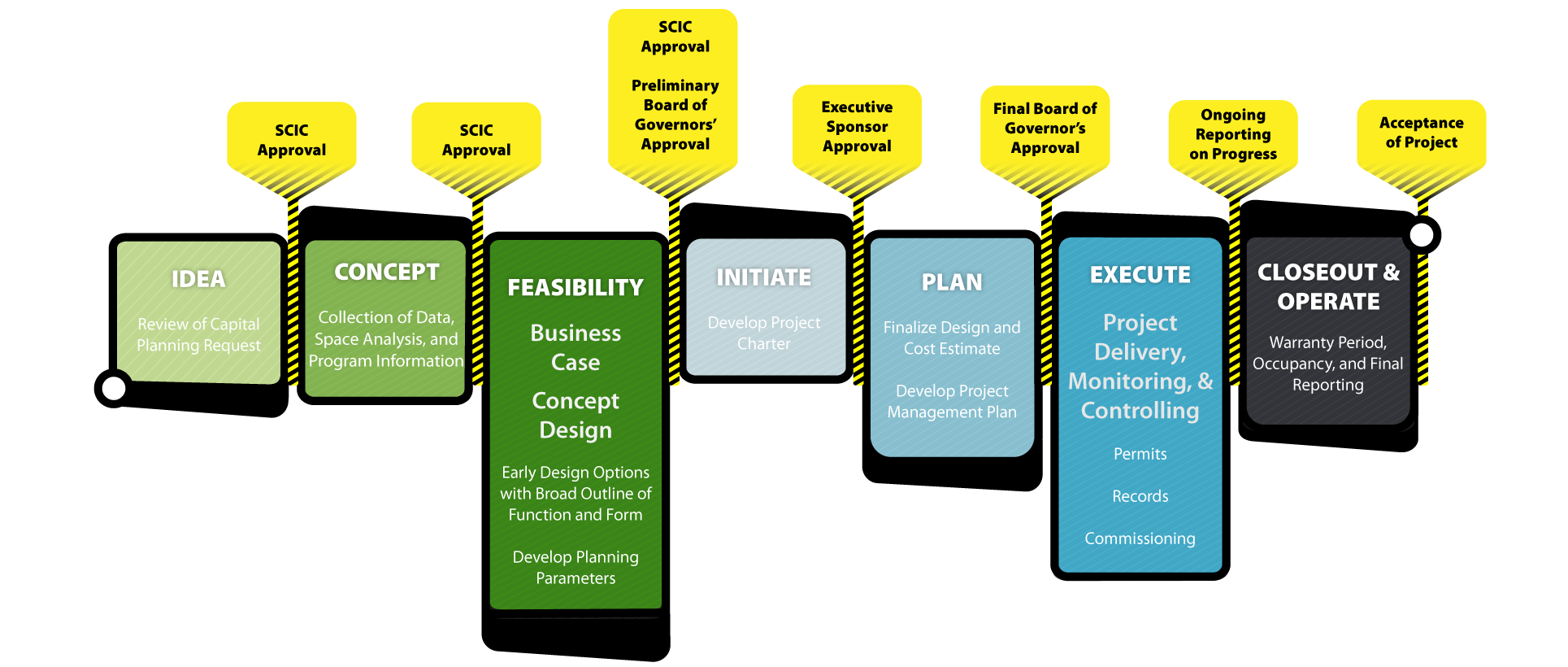Planning for Capital Investments
Planning for capital investment involves developing strategic and logistical capital plans to support the university’s physical assets (i.e. buildings, space, land, infrastructure, and equipment), including critical maintenance and renewal. The goal of planning for capital investments is to ensure and enable effective prioritization and a holistic view of all potential capital ideas, requests and initiatives to ensure USask’s physical infrastructure that supports the research and teaching mission of the University. This goal is supported by several processes including a centralized intake process, as well as evaluation and assessment processes, which are described within the Capital Investment Framework.
To become The University the World Needs, as articulated in the University Plan 2025, Capital planning resources and processes are primarily directed to projects and initiatives that have the highest strategic importance to USask or significant risk to supporting USask’s mission.
Major Capital Projects are defined as any project or initiative in excess of $500,000.
Given the significance of decisions related to USask’s physical assets, a dedicated governance committee—the Strategic Capital Investment Committee (SCIC), comprised of the four USask Vice Presidents—meets regularly to review, evaluate and provide overarching governance for all capital resources (which includes physical infrastructure and space) to ensure USask is making optimal use of its capital resources.
SCIC = Strategic Capital Investment Committee
Directs the alignment of types and uses of space with institutional priorities
The Capital Investment Framework
The Capital Investment Framework outlines a series of stages to enable evidence-based decision-making that:
- Optimizes the value of new and existing assets,
- Achieves intended investment objectives, and
- Recognizes constraints and opportunities (e.g. internal and external funding opportunities, life safety, code and regulatory issues).
The framework serves as a systematic and transparent approach to evaluate and support the development of major capital projects, ensuring that they are managed appropriately from idea through to execution and operation. The Capital Investment Framework also aligns the progress of the project with the required approvals from SCIC, the Board of Governors and the Province of Saskatchewan.
Stages of the Framework
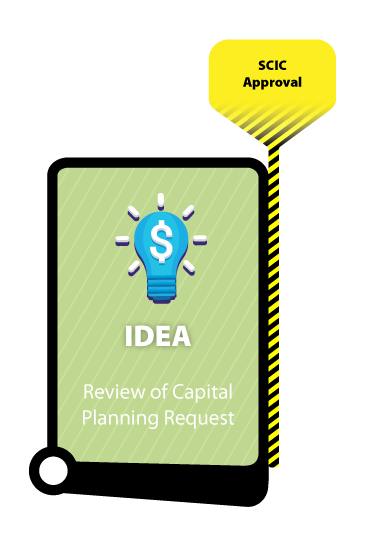
The Idea Stage is the submission of a high-level idea, innovation, improvement or request to address an identified business need. It is the responsibility to the initiator to demonstrate alignment with USask institutional plans and priorities along with obtaining the endorsement of the applicable Vice President(s) prior to review by the Strategic Capital Investment Committee (SCIC) who will determine if the idea has strategic merit and aligns with resourcing capacity; if so, SCIC will determine if the Idea should be promoted forward to the Concept stage.
This stage is initiated by a request for a major capital project. The final deliverable at this stage is a completed Capital Planning Request.
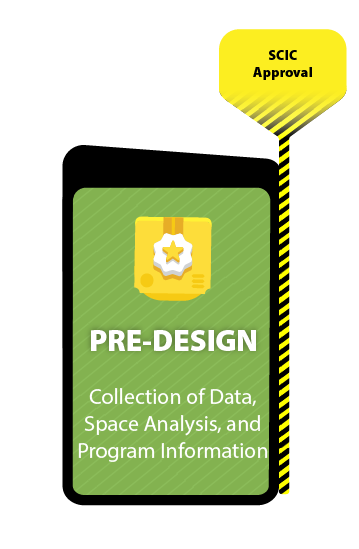
The Pre-Design Stage translates an Idea into a defined capital project with clear parameters and expectations to inform the project design. The review gathers and analyzes building, site and space data (under the principles of the Space Framework) and program requirements to determine if there is alignment with USask institutional plans and support for the concept to move to the Feasibility stage of the Framework.
The Pre-Design stage includes initiation of the Project Charter, preliminary Project Management Plan and the outline of Roles and Responsibilities for all involved groups (both internal and external to the university). Formal project governance is implemented, including the identification of an Executive Sponsor (which must be a USask Vice-President) who accepts the responsibility to determine whether the project is ready to proceed to the next stages. The Sponsor is also identified at this stage of the process.
The deliverable from this stage is the Pre-Design Report that informs, at a high level, if USask has the aspiration and capacity to accommodate the project within existing financial and staffing resources and/or if new resources must be identified prior to promotion to the next stage, Feasibility.
Submission requirements:
- Overall Project Goals
- Needs Assessment
- Scope of Work
- Space review and optimization
- Preliminary total project costs and funding sources
- Cost estimate and secured source of funding to complete Feasibility Stage
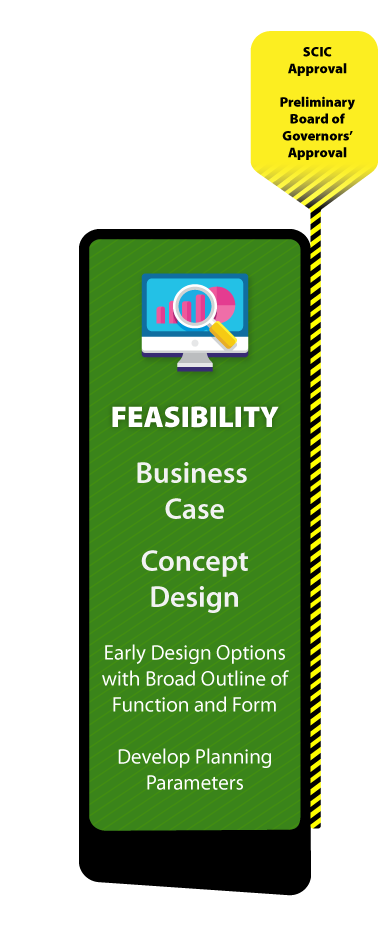
The Feasibility Stage involves the development of both the Schematic Design and the Business Case for the project. The development of these two components is done in parallel with strong linkages between the two areas. The deliverable of this stage is the Planning Parameters document that outlines the limits, constraints, and options within which decision-making and planning take place and form an important foundation for shaping the final options. Approval of the Planning Parameters by SCIC allows the project to move forward to the Plan Stage and allow work to be initiated on a request for preliminary approval from the Board of Governors.
The following are required in order to submit a request for Preliminary Approval from the Board of Governors:
- Submission Requirements:
- Project justification and link to strategic directions.
- Project description and preliminary Schematic Design.
- Capital cost estimate (Class D based on level of design)
- Anticipated cost estimate to prepare for final Board approval.
- Anticipated location.
- Projected funding sources.
- Decision being requested: Approval to continue with planning and design definition of the project including an estimated cost associated with the finalization of the design.
- Request for Approval from Province of Saskatchewan
- Provincial government approval is required for all projects that involve construction of new space (new buildings and changes to existing footprints of existing buildings).
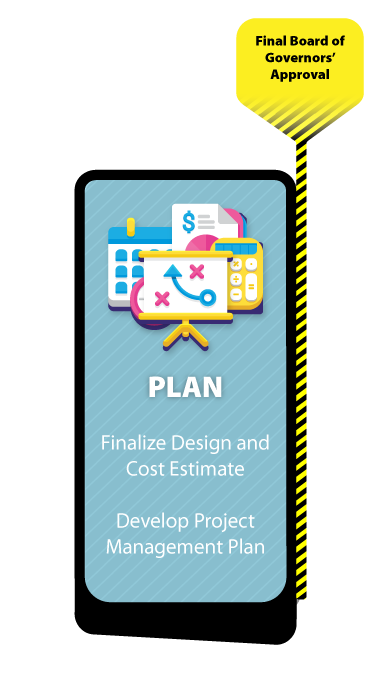
The Plan Stage involves continued development of the management plans for the project, design development and development of contract documents and specifications. At the end of the Plan Stage, the project will be ready to move to physical execution which typically involves hiring external contractors from the community. Completion of the Plan Stage allows the project to move forward with a request for final approval from the Board of Governors.
A Request for Final Approval from Board of Governors will require:
- Submission Requirements:
- Location of project.
- Final project scope description (based on Design to meet program and space requirements)
- Capital Cost Estimate (Class B estimate, 15% contingency, based on Contract drawings and specifications) and operating cost estimates.
- Confirmation of funding sources.
- Projected schedule.
- Decision being requested: Request for approval to proceed with project based on an established scope and budget.
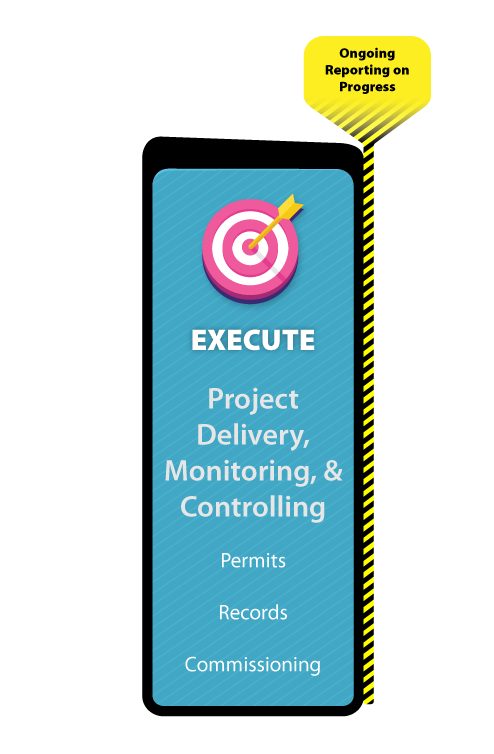
The Execute Stage involves the awarding of the construction contracts and the delivery of the project. Monitoring and Reporting are ongoing throughout the Execution Stage of the project. Execution Stage key deliverables include substantial completion, commissioning, final completion, occupancy permits, and record drawings.

The Closeout and Operate Stage involves acceptance of the final project and transition to operations. This stage includes financial closeout of the project, review of funding agreement compliance, finalization of contracts, record drawings, warranty period and operations handover. Operations will involve the implementation of operating models and the continued monitoring of operations.
Key Projects & Initiatives in Progress
Execution
The following projects/initiatives are currently proceeding through the execution phase.
- Arts Building Renewal
- Thorvaldson Building Renovation
- VIDO – Vaccine Development Centre
- VIDO Storage Addition
- W.P. Thompson Building Renewal – includes Demolition of Biology Greenhouses and Annex
- Rutherford Rink Demolition
- Chiller #4 Replacement (Infrastructure)
Completed Projects
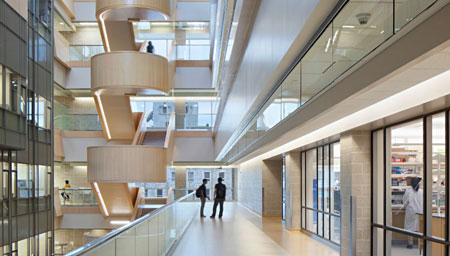
The A-Wing Renovations represent the largest part of the final components of the Health Sciences project and are critical to ensuring the achievement of the overall vision and the efficient operation of the Health Sciences facility. Other components include the C Wing Renovations and connection pieces between the Wings.

The Collaborative Science Research Building (CSRB) will be a flexible laboratory building to support the life and natural sciences areas.

The globally-unique Livestock and Forage Centre of Excellence (LFCE) will partner and integrate USask, the government (including Western Beef Development Centre, WBDC) and numerous industry organizations in 3 physical facilities.

The University is creating a campus hub in Prince Albert (PA) which will provide a strong university presence at the gateway to northern Saskatchewan by consolidating existing programs and integrating any new programs into a centralized learning and community-based scholarship centre.

The Merlis Belsher Place project is a twin pad ice facility, owned by the university and operated by a third party operator. One pad will meet the needs of the university, and the other will be available to the public on a rental basis.
Merlis Belsher Place included a two-court gymnasium which adds significant functionality providing improved and more flexible court access for team and individual basketball practice. The two court gymnasium provides potential for training camps (basketball, hockey, soccer, etc.) taking advantage of sport science, gymnasium, rink, fitness areas, all within one facility. The facility also supports programs and evening opportunities such as badminton, pick up volleyball, pick up basketball, drop-in futsal as well as provide increased opportunity for the Human Performance Centre, dance, club and fitness programs
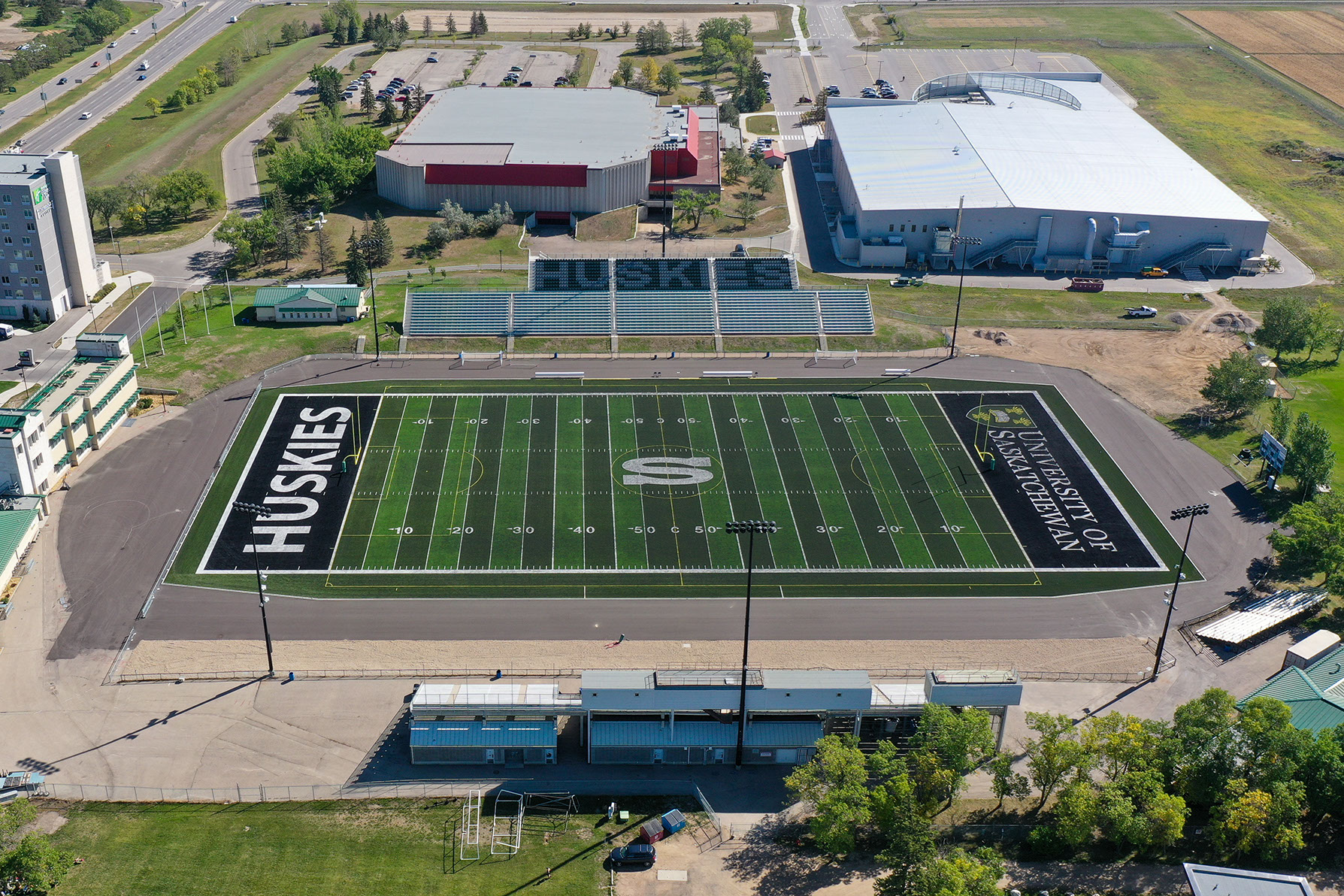
Griffith’s Stadium Turf and Lighting Replacement included replacement of the existing turf and expansion of the field to accommodate regulation-sized football and soccer, and removal of the existing track and associated functions. The replacement of end of life deteriorated lights upgraded lights and reduce the power consumption of the lamps (SmartLamp device, which provides timed power adjustments, in the ballast enclosure is reset) and brought the on-field light levels back in line with the original design and maintain that level for another 5,000 hours.
The Edwards Finance Research and Trading Lab created near the main entry on the ground floor of the Nutrien Centre in the Edwards School of Business (Edwards) Building integrates theory and research with practice by delivering a hands-on learning experience for students. Research databases and real-time access to global financial resources allow students to link classroom lessons to actual securities and markets.
Replacement of two aged existing Agriculture Building transformers ensured continuity of service, addressed potential safety concerns and reduced deferred maintenance requirements.


